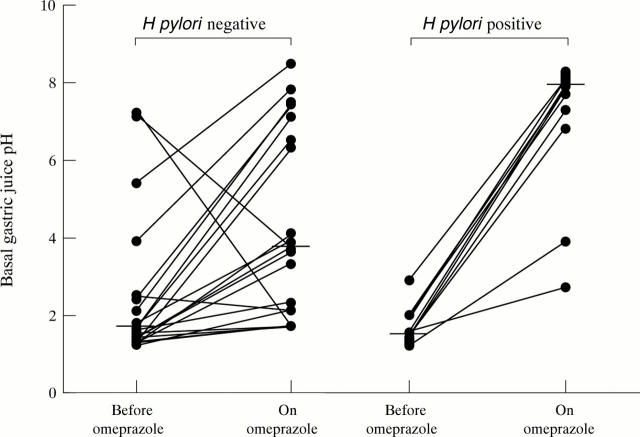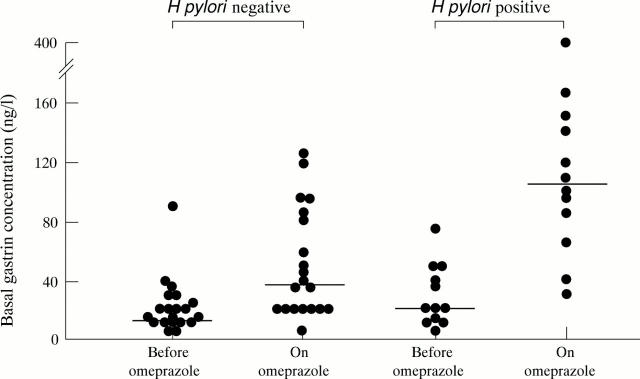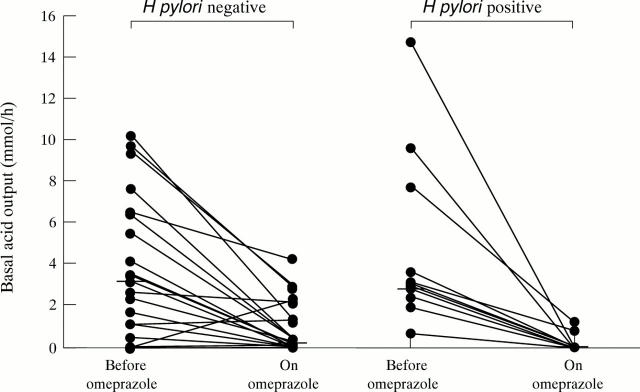Abstract
BACKGROUND—Omeprazole has a greater intragastric pH elevating effect in Helicobacter pylori positive than negative subjects. Ammonia production by H pylori has been suggested as a probable mechanism. AIMS—To assess the effect of H pylori status on gastric acid secretion during omeprazole treatment, and to examine the possible role of ammonia neutralisation of intragastric acid in increased omeprazole efficacy in infected subjects. METHODS—Twenty H pylori positive and 12 H pylori negative healthy volunteers were examined before and six to eight weeks after commencing omeprazole 40 mg/day. On both occasions plasma gastrin and acid output were measured basally and in response to increasing doses of gastrin 17 (G-17). Gastric juice ammonium concentrations were also measured. RESULTS—Prior to omeprazole, measurements were similar in the H pylori positive and negative subjects. During omeprazole, median basal intragastric pH was higher in the H pylori positive (7.95) versus negative (3.75) subjects (p<0.002). During omeprazole basal, submaximal (180 pmol/kg/h G-17), and maximal acid outputs (800 pmol/kg/h G-17) were lower in H pylori positive subjects (0.0, 3.6, 6.0 mmol/h respectively) versus negative subjects (0.3,14.2, 18.6 mmol/h) (p<0.03 for each). This effect was not explained by neutralisation by ammonia. CONCLUSION—The presence of H pylori infection leads to a more profound suppression of acid secretion during omeprazole treatment. The effect cannot be explained by neutralisation of intragastric acid by bacterial ammonia production and its precise mechanism has to be explained.
Keywords: omeprazole; Helicobacter pylori; ammonia; acid secretion
Full Text
The Full Text of this article is available as a PDF (145.4 KB).
Figure 1 .
Basal fasting gastric juice pH in H pylori negative and positive subjects before and during omeprazole treatment. Medians are represented by horizontal bars.
Figure 2 .
Basal plasma gastrin concentrations in the H pylori negative and positive subjects before and during omeprazole treatment. Medians are represented by horizontal bars.
Figure 3 .
Basal acid output in H pylori negative and positive subjects before and during omeprazole treatment. Medians are represented by horizontal bars.
Figure 4 .
Maximal acid output in the H pylori negative and positive subjects before and during omeprazole treatment. Medians are represented by horizontal bars.
Figure 5 .
Median acid outputs (and ranges) to the submaximal doses of G-17 in H pylori negative and positive subjects (A) before and (B) during omeprazole treatment.
Figure 6 .

Median plasma gastrin concentration versus median acid output curves for the H pylori negative and positive subjects before and during omeprazole treatment.
Selected References
These references are in PubMed. This may not be the complete list of references from this article.
- Armstrong D. Helicobacter pylori infection and dyspepsia. Scand J Gastroenterol Suppl. 1996;215:38–47. [PubMed] [Google Scholar]
- Axon A. T., Poole D. Salmonellosis presenting with cholera-like diarrhoea. Lancet. 1973 Apr 7;1(7806):745–746. doi: 10.1016/s0140-6736(73)92129-6. [DOI] [PubMed] [Google Scholar]
- Beil W., Birkholz C., Wagner S., Sewing K. F. Interaction of Helicobacter pylori and its fatty acids with parietal cells and gastric H+/K(+)-ATPase. Gut. 1994 Sep;35(9):1176–1180. doi: 10.1136/gut.35.9.1176. [DOI] [PMC free article] [PubMed] [Google Scholar]
- Bell N. J., Burget D., Howden C. W., Wilkinson J., Hunt R. H. Appropriate acid suppression for the management of gastro-oesophageal reflux disease. Digestion. 1992;51 (Suppl 1):59–67. doi: 10.1159/000200917. [DOI] [PubMed] [Google Scholar]
- Boyd J. F. Pathology of the alimentary tract in Salmonella typhimurium food poisoning. Gut. 1985 Sep;26(9):935–944. doi: 10.1136/gut.26.9.935. [DOI] [PMC free article] [PubMed] [Google Scholar]
- Cave D. R., Vargas M. Effect of a Campylobacter pylori protein on acid secretion by parietal cells. Lancet. 1989 Jul 22;2(8656):187–189. doi: 10.1016/s0140-6736(89)90372-3. [DOI] [PubMed] [Google Scholar]
- Correa P. Human gastric carcinogenesis: a multistep and multifactorial process--First American Cancer Society Award Lecture on Cancer Epidemiology and Prevention. Cancer Res. 1992 Dec 15;52(24):6735–6740. [PubMed] [Google Scholar]
- Danon S. J., O'Rourke J. L., Moss N. D., Lee A. The importance of local acid production in the distribution of Helicobacter felis in the mouse stomach. Gastroenterology. 1995 May;108(5):1386–1395. doi: 10.1016/0016-5085(95)90686-x. [DOI] [PubMed] [Google Scholar]
- Drasar B. S., Shiner M., McLeod G. M. Studies on the intestinal flora. I. The bacterial flora of the gastrointestinal tract in healthy and achlorhydric persons. Gastroenterology. 1969 Jan;56(1):71–79. [PubMed] [Google Scholar]
- Eissele R., Brunner G., Simon B., Solcia E., Arnold R. Gastric mucosa during treatment with lansoprazole: Helicobacter pylori is a risk factor for argyrophil cell hyperplasia. Gastroenterology. 1997 Mar;112(3):707–717. doi: 10.1053/gast.1997.v112.pm9041231. [DOI] [PubMed] [Google Scholar]
- El-Omar E. M., Oien K., El-Nujumi A., Gillen D., Wirz A., Dahill S., Williams C., Ardill J. E., McColl K. E. Helicobacter pylori infection and chronic gastric acid hyposecretion. Gastroenterology. 1997 Jul;113(1):15–24. doi: 10.1016/s0016-5085(97)70075-1. [DOI] [PubMed] [Google Scholar]
- Feldman M., Cryer B., McArthur K. E., Huet B. A., Lee E. Effects of aging and gastritis on gastric acid and pepsin secretion in humans: a prospective study. Gastroenterology. 1996 Apr;110(4):1043–1052. doi: 10.1053/gast.1996.v110.pm8612992. [DOI] [PubMed] [Google Scholar]
- Fellenius E., Berglindh T., Sachs G., Olbe L., Elander B., Sjöstrand S. E., Wallmark B. Substituted benzimidazoles inhibit gastric acid secretion by blocking (H+ + K+)ATPase. Nature. 1981 Mar 12;290(5802):159–161. doi: 10.1038/290159a0. [DOI] [PubMed] [Google Scholar]
- Ferrero R. L., Hazell S. L., Lee A. The urease enzymes of Campylobacter pylori and a related bacterium. J Med Microbiol. 1988 Sep;27(1):33–40. doi: 10.1099/00222615-27-1-33. [DOI] [PubMed] [Google Scholar]
- Fändriks L., Stage L. Simultaneous measurements of gastric motility and acid-bicarbonate secretions in the anaesthetized cat. Acta Physiol Scand. 1986 Dec;128(4):563–573. doi: 10.1111/j.1748-1716.1986.tb08013.x. [DOI] [PubMed] [Google Scholar]
- Garner A., Fadlallah H., Parsons M. E. 1976 and all that!--20 years of antisecretory therapy. Gut. 1996 Dec;39(6):784–786. doi: 10.1136/gut.39.6.784. [DOI] [PMC free article] [PubMed] [Google Scholar]
- Giannella R. A., Broitman S. A., Zamcheck N. Gastric acid barrier to ingested microorganisms in man: studies in vivo and in vitro. Gut. 1972 Apr;13(4):251–256. doi: 10.1136/gut.13.4.251. [DOI] [PMC free article] [PubMed] [Google Scholar]
- Gillen D., el-Omar E. M., Wirz A. A., Ardill J. E., McColl K. E. The acid response to gastrin distinguishes duodenal ulcer patients from Helicobacter pylori-infected healthy subjects. Gastroenterology. 1998 Jan;114(1):50–57. doi: 10.1016/s0016-5085(98)70632-8. [DOI] [PubMed] [Google Scholar]
- Graham D. Y. Campylobacter pylori and peptic ulcer disease. Gastroenterology. 1989 Feb;96(2 Pt 2 Suppl):615–625. doi: 10.1016/s0016-5085(89)80057-5. [DOI] [PubMed] [Google Scholar]
- Graham D. Y., Klein P. D., Opekun A. R., Boutton T. W. Effect of age on the frequency of active Campylobacter pylori infection diagnosed by the [13C]urea breath test in normal subjects and patients with peptic ulcer disease. J Infect Dis. 1988 Apr;157(4):777–780. doi: 10.1093/infdis/157.4.777. [DOI] [PubMed] [Google Scholar]
- Hassan M. A., Hobsley M. Positioning of subject and of nasogastric tube during a gastric secretion study. Br Med J. 1970 Feb 21;1(5694):458–460. doi: 10.1136/bmj.1.5694.458. [DOI] [PMC free article] [PubMed] [Google Scholar]
- Hetzel D. J., Dent J., Reed W. D., Narielvala F. M., Mackinnon M., McCarthy J. H., Mitchell B., Beveridge B. R., Laurence B. H., Gibson G. G. Healing and relapse of severe peptic esophagitis after treatment with omeprazole. Gastroenterology. 1988 Oct;95(4):903–912. doi: 10.1016/0016-5085(88)90162-x. [DOI] [PubMed] [Google Scholar]
- Howden C. W., Forrest J. A., Reid J. L. Effects of single and repeated doses of omeprazole on gastric acid and pepsin secretion in man. Gut. 1984 Jul;25(7):707–710. doi: 10.1136/gut.25.7.707. [DOI] [PMC free article] [PubMed] [Google Scholar]
- Howden C. W., Hunt R. H. The relationship between suppression of acidity and gastric ulcer healing rates. Aliment Pharmacol Ther. 1990 Feb;4(1):25–33. doi: 10.1111/j.1365-2036.1990.tb00445.x. [DOI] [PubMed] [Google Scholar]
- KUNZ L. J., WADDELL W. R. Association of Salmonella enteritis with operations on the stomach. N Engl J Med. 1956 Sep 20;255(12):555–559. doi: 10.1056/NEJM195609202551203. [DOI] [PubMed] [Google Scholar]
- Klinkenberg-Knol E. C., Festen H. P., Jansen J. B., Lamers C. B., Nelis F., Snel P., Lückers A., Dekkers C. P., Havu N., Meuwissen S. G. Long-term treatment with omeprazole for refractory reflux esophagitis: efficacy and safety. Ann Intern Med. 1994 Aug 1;121(3):161–167. doi: 10.7326/0003-4819-121-3-199408010-00001. [DOI] [PubMed] [Google Scholar]
- Klinkenberg-Knol E. C., Jansen J. B., Lamers C. B., Nelis F., Snel P., Meuwissen S. G. Use of omeprazole in the management of reflux oesophagitis resistant to H2-receptor antagonists. Scand J Gastroenterol Suppl. 1989;166:88–94. doi: 10.3109/00365528909091251. [DOI] [PubMed] [Google Scholar]
- Koop H., Arnold R. Long-term maintenance treatment of reflux esophagitis with omeprazole. Prospective study in patients with H2-blocker-resistant esophagitis. Dig Dis Sci. 1991 May;36(5):552–557. doi: 10.1007/BF01297018. [DOI] [PubMed] [Google Scholar]
- Koop H., Kuly S., Flüg M., Eissele R., Mönnikes H., Rose K., Lühmann R., Schneider A., Fischer R., Arnold R. Intragastric pH and serum gastrin during administration of different doses of pantoprazole in healthy subjects. Eur J Gastroenterol Hepatol. 1996 Sep;8(9):915–918. [PubMed] [Google Scholar]
- Kubben F. J., Peeters-Haesevoets A., Engels L. G., Baeten C. G., Schutte B., Arends J. W., Stockbrügger R. W., Blijham G. H. Proliferating cell nuclear antigen (PCNA): a new marker to study human colonic cell proliferation. Gut. 1994 Apr;35(4):530–535. doi: 10.1136/gut.35.4.530. [DOI] [PMC free article] [PubMed] [Google Scholar]
- Kuipers E. J., Uyterlinde A. M., Peña A. S., Hazenberg H. J., Bloemena E., Lindeman J., Klinkenberg-Knol E. C., Meuwissen S. G. Increase of Helicobacter pylori-associated corpus gastritis during acid suppressive therapy: implications for long-term safety. Am J Gastroenterol. 1995 Sep;90(9):1401–1406. [PubMed] [Google Scholar]
- Labenz J., Tillenburg B., Peitz U., Idström J. P., Verdú E. F., Stolte M., Börsch G., Blum A. L. Helicobacter pylori augments the pH-increasing effect of omeprazole in patients with duodenal ulcer. Gastroenterology. 1996 Mar;110(3):725–732. doi: 10.1053/gast.1996.v110.pm8608881. [DOI] [PubMed] [Google Scholar]
- Ladas S. D., Katsogridakis J., Malamou H., Giannopoulou H., Kesse-Elia M., Raptis S. A. Helicobacter pylori may induce bile reflux: link between H pylori and bile induced injury to gastric epithelium. Gut. 1996 Jan;38(1):15–18. doi: 10.1136/gut.38.1.15. [DOI] [PMC free article] [PubMed] [Google Scholar]
- Leite L. P., Johnston B. T., Just R. J., Castell D. O. Persistent acid secretion during omeprazole therapy: a study of gastric acid profiles in patients demonstrating failure of omeprazole therapy. Am J Gastroenterol. 1996 Aug;91(8):1527–1531. [PubMed] [Google Scholar]
- Logan R. P., Walker M. M., Misiewicz J. J., Gummett P. A., Karim Q. N., Baron J. H. Changes in the intragastric distribution of Helicobacter pylori during treatment with omeprazole. Gut. 1995 Jan;36(1):12–16. doi: 10.1136/gut.36.1.12. [DOI] [PMC free article] [PubMed] [Google Scholar]
- Lorentzon P., Jackson R., Wallmark B., Sachs G. Inhibition of (H+ + K+)-ATPase by omeprazole in isolated gastric vesicles requires proton transport. Biochim Biophys Acta. 1987 Feb 12;897(1):41–51. doi: 10.1016/0005-2736(87)90313-0. [DOI] [PubMed] [Google Scholar]
- Lundell L., Backman L., Ekström P., Enander L. H., Fausa O., Lind T., Lönroth H., Sandmark S., Sandzén B., Unge P. Omeprazole or high-dose ranitidine in the treatment of patients with reflux oesophagitis not responding to 'standard doses' of H2-receptor antagonists. Aliment Pharmacol Ther. 1990 Apr;4(2):145–155. doi: 10.1111/j.1365-2036.1990.tb00459.x. [DOI] [PubMed] [Google Scholar]
- Marshall B. J., Warren J. R. Unidentified curved bacilli in the stomach of patients with gastritis and peptic ulceration. Lancet. 1984 Jun 16;1(8390):1311–1315. doi: 10.1016/s0140-6736(84)91816-6. [DOI] [PubMed] [Google Scholar]
- Maton P. N., Vinayek R., Frucht H., McArthur K. A., Miller L. S., Saeed Z. A., Gardner J. D., Jensen R. T. Long-term efficacy and safety of omeprazole in patients with Zollinger-Ellison syndrome: a prospective study. Gastroenterology. 1989 Oct;97(4):827–836. doi: 10.1016/0016-5085(89)91485-6. [DOI] [PubMed] [Google Scholar]
- McGowan C. C., Cover T. L., Blaser M. J. The proton pump inhibitor omeprazole inhibits acid survival of Helicobacter pylori by a urease-independent mechanism. Gastroenterology. 1994 Sep;107(3):738–743. doi: 10.1016/0016-5085(94)90121-x. [DOI] [PubMed] [Google Scholar]
- Mowat C., Murray L., Hilditch T. E., Kelman A., Oien K., McColl K. E. Comparison of helisal rapid blood test and 14C-urea breath test in determining Helicobacter pylori status and predicting ulcer disease in dyspeptic patients. Am J Gastroenterol. 1998 Jan;93(1):20–25. doi: 10.1111/j.1572-0241.1998.020_c.x. [DOI] [PubMed] [Google Scholar]
- Mulholland G., Ardill J. E., Fillmore D., Chittajallu R. S., Fullarton G. M., McColl K. E. Helicobacter pylori related hypergastrinaemia is the result of a selective increase in gastrin 17. Gut. 1993 Jun;34(6):757–761. doi: 10.1136/gut.34.6.757. [DOI] [PMC free article] [PubMed] [Google Scholar]
- Neithercut W. D., el Nujumi A. M., McColl K. E. Measurement of urea and ammonium concentrations in gastric juice. J Clin Pathol. 1993 May;46(5):462–464. doi: 10.1136/jcp.46.5.462. [DOI] [PMC free article] [PubMed] [Google Scholar]
- Olbe L., Haglund U., Leth R., Lind T., Cederberg C., Ekenved G., Elander B., Fellenius E., Lundborg P., Wallmark B. Effects of substituted benzimidazole (H 149/94) on gastric acid secretion in humans. Gastroenterology. 1982 Jul;83(1 Pt 2):193–198. [PubMed] [Google Scholar]
- Robert A., Olafsson A. S., Lancaster C., Zhang W. R. Interleukin-1 is cytoprotective, antisecretory, stimulates PGE2 synthesis by the stomach, and retards gastric emptying. Life Sci. 1991;48(2):123–134. doi: 10.1016/0024-3205(91)90405-z. [DOI] [PubMed] [Google Scholar]
- Ruddell W. S., Losowsky M. S. Severe diarrehoea due to small intestinal colonisation during cimetidine treatment. Br Med J. 1980 Jul 26;281(6235):273–273. doi: 10.1136/bmj.281.6235.273. [DOI] [PMC free article] [PubMed] [Google Scholar]
- Sachs G. Gastritis, Helicobacter pylori, and proton pump inhibitors. Gastroenterology. 1997 Mar;112(3):1033–1036. doi: 10.1053/gast.1997.v112.agast971033. [DOI] [PubMed] [Google Scholar]
- Sontag S. J., Hirschowitz B. I., Holt S., Robinson M. G., Behar J., Berenson M. M., McCullough A., Ippoliti A. F., Richter J. E., Ahtaridis G. Two doses of omeprazole versus placebo in symptomatic erosive esophagitis: the U.S. Multicenter Study. Gastroenterology. 1992 Jan;102(1):109–118. doi: 10.1016/0016-5085(92)91790-b. [DOI] [PubMed] [Google Scholar]
- Taché Y., Saperas E. Potent inhibition of gastric acid secretion and ulcer formation by centrally and peripherally administered interleukin-1. Ann N Y Acad Sci. 1992;664:353–368. doi: 10.1111/j.1749-6632.1992.tb39774.x. [DOI] [PubMed] [Google Scholar]
- The British Society of Gastroenterology spring meeting 20-22 March 1996. Abstracts. Gut. 1996;38 (Suppl 1):A1–73. [PMC free article] [PubMed] [Google Scholar]
- Unreviewed reports. Br Med J (Clin Res Ed) 1984 Nov 10;289(6454):1272–1272. [PMC free article] [PubMed] [Google Scholar]
- Verdú E. F., Armstrong D., Fraser R., Viani F., Idström J. P., Cederberg C., Blum A. L. Effect of Helicobacter pylori status on intragastric pH during treatment with omeprazole. Gut. 1995 Apr;36(4):539–543. doi: 10.1136/gut.36.4.539. [DOI] [PMC free article] [PubMed] [Google Scholar]
- Verdú E. F., Armstrong D., Idström J. P., Labenz J., Stolte M., Dorta G., Börsch G., Blum A. L. Effect of curing Helicobacter pylori infection on intragastric pH during treatment with omeprazole. Gut. 1995 Dec;37(6):743–748. doi: 10.1136/gut.37.6.743. [DOI] [PMC free article] [PubMed] [Google Scholar]
- Vigneri S., Termini R., Leandro G., Badalamenti S., Pantalena M., Savarino V., Di Mario F., Battaglia G., Mela G. S., Pilotto A. A comparison of five maintenance therapies for reflux esophagitis. N Engl J Med. 1995 Oct 26;333(17):1106–1110. doi: 10.1056/NEJM199510263331703. [DOI] [PubMed] [Google Scholar]
- Wallace J. L., Cucala M., Mugridge K., Parente L. Secretagogue-specific effects of interleukin-1 on gastric acid secretion. Am J Physiol. 1991 Oct;261(4 Pt 1):G559–G564. doi: 10.1152/ajpgi.1991.261.4.G559. [DOI] [PubMed] [Google Scholar]
- Walt R. P., Gomes M. D., Wood E. C., Logan L. H., Pounder R. E. Effect of daily oral omeprazole on 24 hour intragastric acidity. Br Med J (Clin Res Ed) 1983 Jul 2;287(6384):12–14. doi: 10.1136/bmj.287.6384.12. [DOI] [PMC free article] [PubMed] [Google Scholar]
- Yasunaga Y., Shinomura Y., Kanayama S., Yabu M., Nakanishi T., Miyazaki Y., Murayama Y., Bonilla-Palacios J. J., Matsuzawa Y. Improved fold width and increased acid secretion after eradication of the organism in Helicobacter pylori associated enlarged fold gastritis. Gut. 1994 Nov;35(11):1571–1574. doi: 10.1136/gut.35.11.1571. [DOI] [PMC free article] [PubMed] [Google Scholar]







